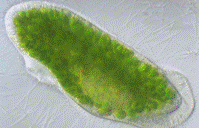Biological Sciences, School of

School of Biological Sciences: Faculty Publications
Document Type
Article
Date of this Version
2016
Citation
Microorganisms 2016, 4, 37; doi:10.3390/microorganisms4030037
Abstract
Due to the increased number of immunocompromised patients, infections with the pathogen Candida albicans have significantly increased in recent years. C. albicans transition from yeast to germ tubes is one of the essential factors for virulence. In this study we noted that Lee’s medium, commonly used to induce filamentation, contained 500-fold more biotin than needed for growth and 40-fold more biotin than is typically added to growth media. Thus, we investigated the effects of excess biotin on growth rate and filamentation by C. albicans in different media. At 37 ˚C, excess biotin (4 µM) enhanced germ tube formation (GTF) ca. 10-fold in both Lee’s medium and a defined glucose-proline medium, and ca. 4-fold in 1% serum. Two biotin precursors, desthiobiotin and 7-keto-8-aminopelargonic acid (KAPA), also stimulated GTF. During these studies we also noted an inverse correlation between the number of times the inoculum had been washed and the concentration of serum needed to stimulate GTF. C. albicans cells that had been washed eight times achieved 80% GTF with only 0.1% sheep serum. The mechanism by which 1–4 µM biotin enhances GTF is still unknown except to note that equivalent levels of biotin are needed to create an internal supply of stored biotin and biotinylated histones. Biotin did not restore filamentation for any of the four known filamentation defective mutants tested. C. albicans is auxotrophic for biotin and this biotin auxotrophy was fulfilled by biotin, desthiobiotin, or KAPA. However, biotin auxotrophy is not temperature dependent or influenced by the presence of 5% CO2. Biotin starvation upregulated the biotin biosynthetic genes BIO2, BIO3, and BIO4 by 11-, 1500-, and 150-fold, respectively, and BIO2p is predicted to be mitochondrion-localized. Based on our findings, we suggest that biotin has two roles in the physiology of C. albicans, one as an enzymatic cofactor and another as a morphological regulator. Finally, we found no evidence supporting prior claims that C. albicans only forms hyphae at very low biotin (0.1 nM) growth conditions.


Comments
This document is published under a Creative Commons/Open Access license.